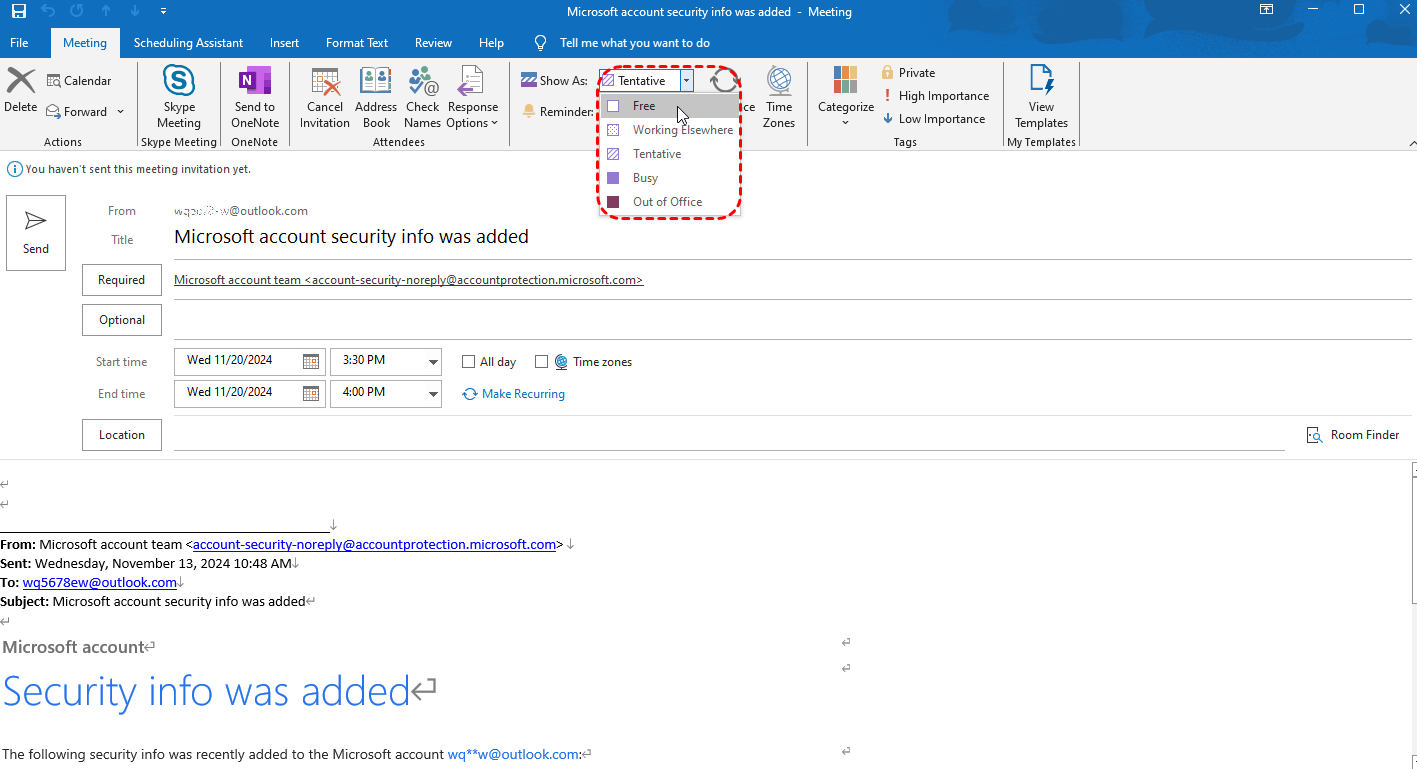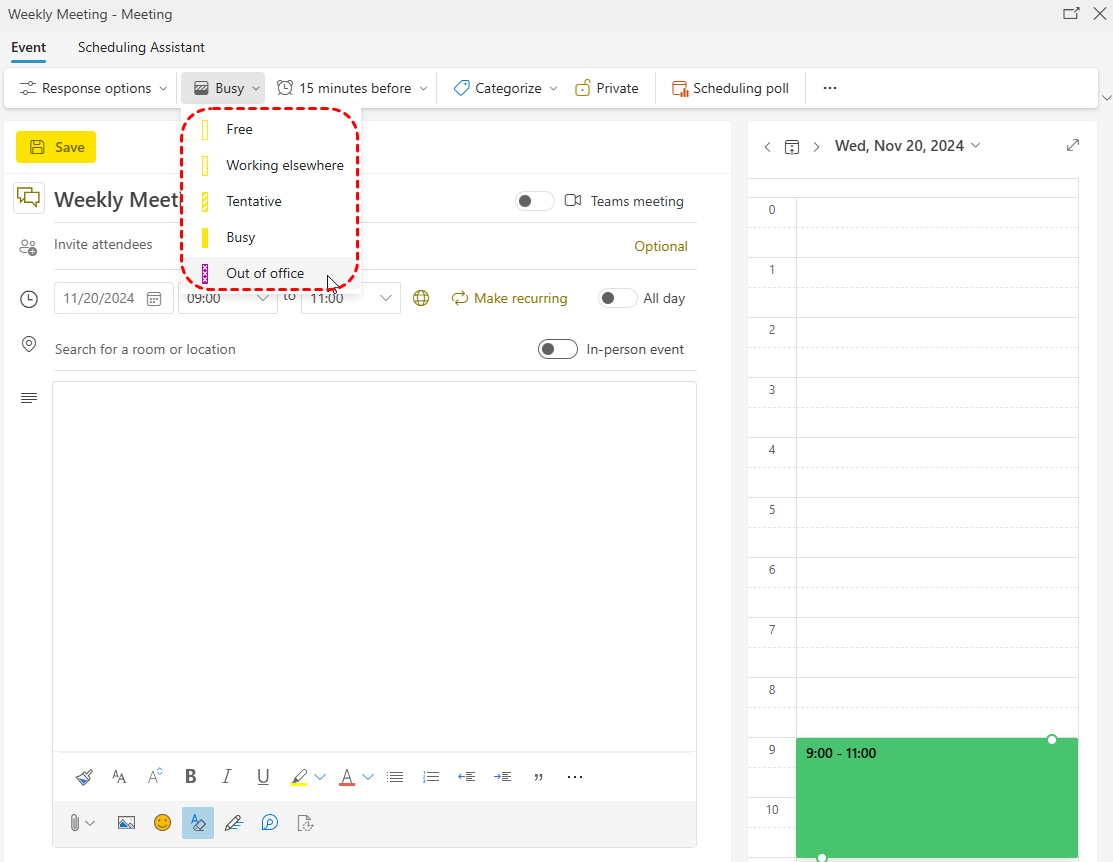What Is Availability Options in Outlook And When Need It?
Availability options in Outlook are a set of settings that control how your free/busy time is displayed to others. By adjusting your availability status, you can indicate whether you're available for meetings, busy, or out of office. This information is crucial for efficient scheduling, especially in team environments. The available status you can choose from include:
- Available: Indicates that you're available for meetings and calls.
- Busy: Shows that you're currently occupied and not available for meetings.
- Do Not Disturb: Signals that you're working on important tasks and should not be interrupted.
- Out of Office: Indicates that you're away from your desk and unavailable.
- Be Right Back: Shows that you'll be away briefly and will return shortly.
- Custom Status: Allows you to set a custom status message, such as "Working on a project" or "In a meeting."
When to Use Availability Options
You should use availability options in the following scenarios:
- Scheduling Meetings: When scheduling meetings, you can check the availability of other attendees to find a time that works for everyone.
- Receiving Meeting Requests: When you receive a meeting request, Outlook will automatically check your availability and suggest alternative times if there's a conflict.
- Sharing Your Schedule: You can share your availability with colleagues or clients to give them a better understanding of your schedule.
- Remote Work and Flexible Schedules: For remote workers or people with flexible schedules, availability options can help you manage your time effectively and avoid overbooking.
How to Adjust Availability Status in Outlook (Classic)
Step 1. Open Home Menu: Launch your Outlook application. Go to the "Home" tab.
Step 2. Meeting: Select "Meeting" in the Respond section.
Step 3. Select Status: In the Meeting window tab, you can choose "Free", "Working Elsewhere", "Tentative", "Busy" or "Out of Office" from the "Show As" drop-down menu.
How to Adjust Availability Status in Outlook (New)
Step 1. Open the New Outlook version.
Step 2. In the left pane, select "Calendar."
Step 3. Click on "New Event" button in the Calendar window.
Step 4. Specify the time in which you would like to change status and then set status.
Your Outlook calendar automatically updates your availability status based on scheduled events. When you add a meeting or appointment to your calendar, it will show as busy during that time in your free/busy information. This ensures that your availability is accurately reflected in your calendar and prevents scheduling conflicts.
Conclusion
With a proper availability settings in Outlook, you can improve your time management, avoid scheduling conflicts, and enhance your overall productivity. By understanding and utilizing these features, you can streamline your workflow and maintain a balanced schedule.
Bonus Tip: How to Manage and Back up Outlook Emails
This article addresses the question “how to set availability in Outlook?”. If you’re considering backing up your Outlook, MultCloud can be extremely useful. Trusted by over 3 million users, MultCloud is a multi-cloud management tool that facilitates the transfer or synchronization of files between various cloud services.
For instance, you can save your Outlook emails as PDFs to your computer or cloud drives, such as Google Drive, OneDrive, or Dropbox, in bulk. MultCloud also enables you to access and manage all your cloud or Email accounts via a single application. Currently, it supports more than 30 different cloud services, including Google Drive, OneDrive, Dropbox, Box, Google Photos, iCloud Photos, FTP, WebDav, and more.

- Cloud Transfer: MultCloud can transfer files from one cloud service to another directly without downloading and re-uploading.
- Cloud Sync: With MultCloud, you can easily sync two folders between different cloud services in real-time.
- Cloud Backup: You can backup and restore data between different cloud services automatically.
- Instagram Downloader: MultCloud can help you download Instagram videos, photos, reels and stories to local device or remotely upload them to your clouds.
- Email Migration: You can directly back up and save Gmail emails as PDFs to your computer or cloud drive in bulk.
- Manage all cloud accounts in one place: Connect all your clouds to MultCloud and you'll find it so easy to access and manage multiple cloud storage files with a single login.
MultCloud Supports Clouds
-
Google Drive
-
Google Workspace
-
OneDrive
-
OneDrive for Business
-
SharePoint
-
Dropbox
-
Dropbox Business
-
MEGA
-
Google Photos
-
iCloud Photos
-
FTP
-
box
-
box for Business
-
pCloud
-
Baidu
-
Flickr
-
HiDrive
-
Yandex
-
NAS
-
WebDAV
-
MediaFire
-
iCloud Drive
-
WEB.DE
-
Evernote
-
Amazon S3
-
Wasabi
-
ownCloud
-
MySQL
-
Egnyte
-
Putio
-
ADrive
-
SugarSync
-
Backblaze
-
CloudMe
-
MyDrive
-
Cubby


